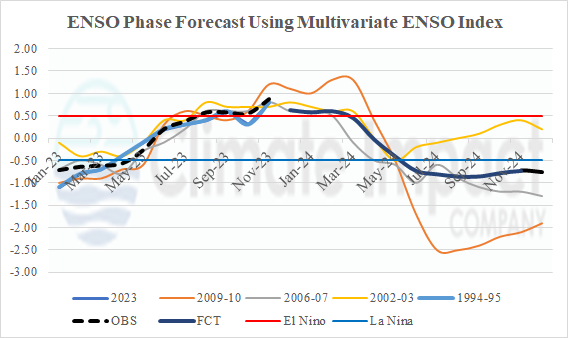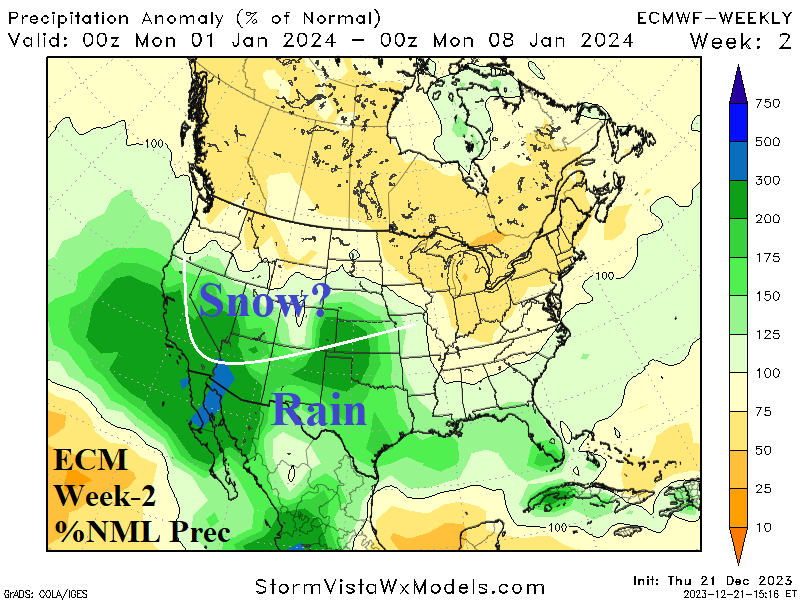
Southern Half of U.S. Looks Colder/Stormy First Half of January
12/21/2023, 5:42 pm EST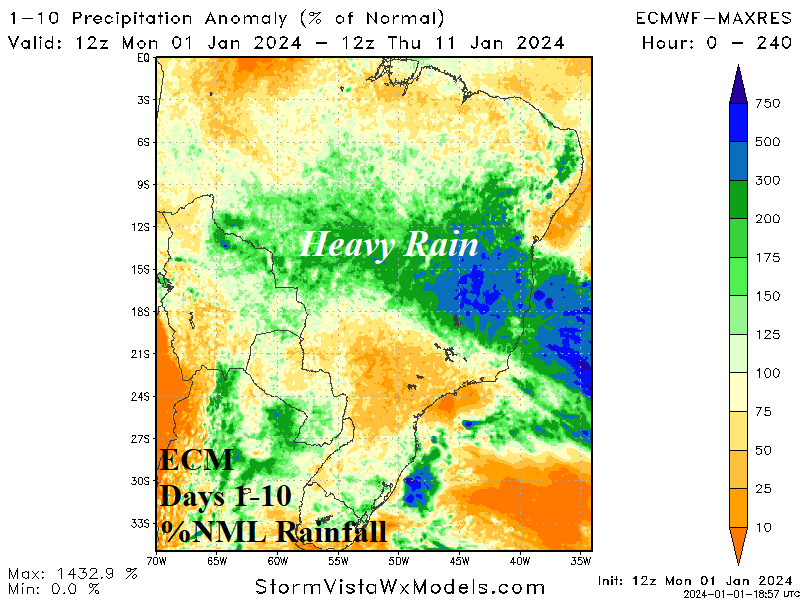
Brazil and East Australia Rains Ahead; More Arctic Air Northwest Eurasia.
01/01/2024, 3:59 pm ESTDiscussion: There are concerns regarding regenerating (or continued) drought across key crop areas in 2024 inhibiting the growing seasons. The catalyst to this condition is ongoing El Nino. Area’s susceptible to dryness are the rice crop across East and Southeast Asia, wheat crop areas in India and Australia, palm oil output in Southeast Asia/Indonesia, and possibly the Midwest U.S. crop zone (Fig. 1). In South America, Brazil drought risk remains a concern while Argentina rains are ending the long-term drought of earlier this decade.
The ENSO forecast for 2024 is generally agreed upon by most dynamic and statistical models projecting a decelerating El Nino during MAR/APR/MAY (northern hemisphere meteorological spring) and neutral ENSO mid-year (Fig. 2). The NCEP CFS V2 model indicates risk of an ENSO phase reversal to La Nina by JUL/AUG (Fig. 3).
The 2023 El Nino is unique producing a strong oceanic signature but a considerably weaker El Nino climate. Australia Bureau of Meteorology has stated that El Nino 2023 is 7th strongest (since 1950). The oceanic El Nino is steady with a weekly Nino34 SSTA of +2.0C (Fig. 4). Atmospheric El Nino continues to lag as southern oscillation index (SOI) is projected in neutral phase for December (Fig. 5) although the past 3 days were strong negative. By comparison, note the monthly SOI for 2015 observed during the last strong oceanic and atmospheric El Nino.
Given a decelerating El Nino and a weaker than normal El Nino climate, will drought conditions appear in 2024 as feared by grain markets? Using solely the multivariate ENSO index (MEI) to generate an analog for 2024 precipitation climate across major crop areas yields decelerating El Nino to neutral phase during Q2/2024 and La Nina for the second half of 2024 (Fig. 6). The analog years are 1994-95, 2002-03, 2006-07, and 2009-10.
Results yield a dry meteorological spring 2024 across Southeast Asia likely to accelerate drought in that region (Fig. 7). However, Western Indonesia is wet. During JUN/JUL/AUG 2024 a major pattern change as Southern India to Indonesia to Eastern Australia each turn wet (Fig. 8).
In South America, dryness is projected across Brazil during MAR/APR/MAY 2024 while Argentina is wet (Fig. 9). Any summertime Brazil drought is likely to linger. Next winter is unseasonably dry in Paraguay and the dry pattern is shifting south again into Argentina (Fig. 10).
A wet meteorological spring 2024 is indicated for the Great Plains while the Mid-south States reverse drier (Fig. 11). During meteorological summer 2024, a wet pattern convenes over Texas and may extend to Iowa (Fig. 12).
During meteorological spring 2024 a dry climate a dry climate emerges across U.K., Portugal, Northern Italy, Ukraine, and all Southwest Russia (Fig. 13). Wet climate is projected across Northern Europe during spring. The JUN/JUL/AUG 2024 outlook indicates a marginal dry climate stretched across the Black Sea region and continues in the British Isles (Fig. 14). Dryness continues West-central Russia.
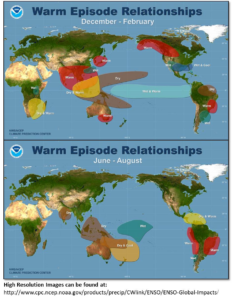
Fig. 1: Common El Nino climate anomalies during DEC/JAN/FEB and JUN/JUL/AUG according to NOAA.
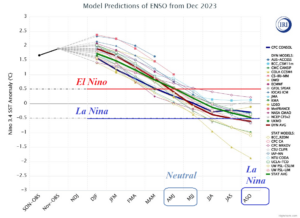
Fig. 2: A collection of dynamic and statistical Nino34 SSTA forecasts by the International Research Institute for Climate and Society.

Fig. 3: The NCEP CFS V2 Nino34 SSTA forecast indicates a rapidly decelerating El Nino early in 2024 with reversal to La Nina the second half of 2024.
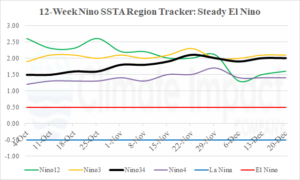
Fig. 4: Weekly Nino SSTA regions indicate oceanic El Nino is steadily moderate-to-strong intensity.

Fig. 5: The southern oscillation index monthly negative values for 2023 are considerably weaker than the last strong El Nino observed in 2015.
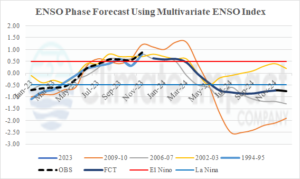
Fig. 6: Using multivariate ENSO index identifying a weaker El Nino climate similar to 2023 to project ENSO phase for 2024.
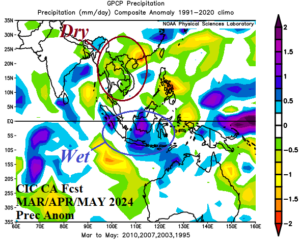
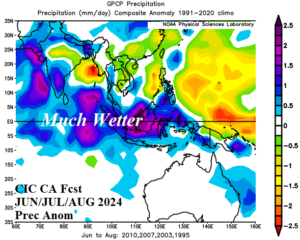
Fig. 7-8: A constructed analog precipitation anomaly forecast based on MEI for Asia and Australia valid MAR/APR/MAY and JUN/JUL/AUG 2024.
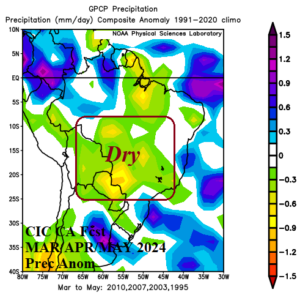
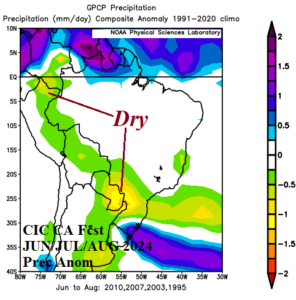
Fig. 9-10: A constructed analog precipitation anomaly forecast based on MEI for South America valid MAR/APR/MAY and JUN/JUL/AUG 2024.
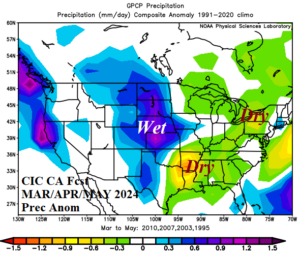
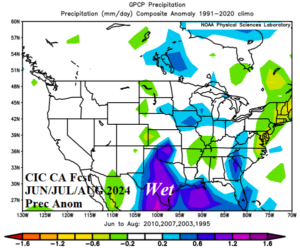
Fig. 11-12: A constructed analog precipitation anomaly forecast based on MEI for the U.S. valid MAR/APR/MAY and JUN/JUL/AUG 2024.
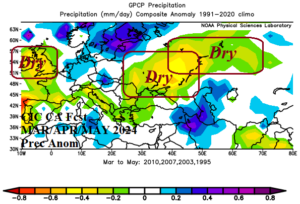
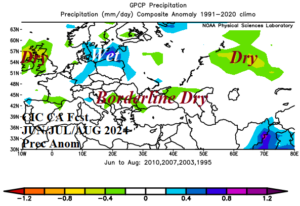
Fig. 13-14: A constructed analog precipitation anomaly forecast based on MEI for Europe and Russia valid MAR/APR/MAY and JUN/JUL/AUG 2024.
Summary: Based on a MEI-driven constructed analog, drought concern for MAR/APR/MAY 2024 are likely for Brazil, Southeast Asia, the Mid-south U.S., and developing in U.K. plus the Black Sea region to West-central Russia. During JUN/JUL/AUG 2024, drought is likely to continue in the Black Sea region to West-central Russia, the British Isles, Western Tennessee Valley, and emerge in the Northeast U.S. Dryness shifts south back into Argentina during JUN/JUL/AUG 2024. A complete change to a wetter than normal climate stretches from Southern India through Indonesia to Eastern Australia during mid-year.
![Climate-Impact-Company-logo-sm[1]](https://climateimpactcompany.com/wp-content/uploads/2023/08/Climate-Impact-Company-logo-sm1.png)
